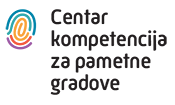Within the Energy & Environment subproject, Apsolon is exploring the concept of urban monitoring and management systems by developing key performance indicators – KPI Evaluator, which aims to improve energy systems and environmental monitoring systems in the smart cities. The KPI Evaluator will develop a transparent and balanced, scalable conceptual evaluation framework with associated metrics and a budget and analytics application platform for dynamic management and decision support in the function of optimizing resource management and smart cities sustainable development.
The starting point in this solution development is the data collection and monitoring based on which cities will be able to decide on future development. Namely, with the development of this solution, cities in Croatia will be able to monitor key and relevant indicators in the field of energy efficiency and sustainable environment, but also other aspects of the city management through an innovative and interactive presentation platform. The system will enable monitoring of development through a system of key performance indicators over time, as well as a comparison of two or more cities.

The composite indices
The task within this project activity was to formalize the process of composite indices calculation, which have recently become increasingly recognized as a very useful tool in analyzing individual policies and communicating to the public. All indicators are grouped into four large groups, which will be used to measure a stage of an individual city development in Croatia based on several different indicators:
- Economy and labor market;
- Energetics, environmental, transport, and spatial planning monitoring;
- Education, sports, culture and civil society, health and social welfare;
- Management and IT.
Based on a number of indicators in each of the four mentioned groups, four composite indices are calculated for each city, and based on these indices, the cities are compared and given the possibility to monitor their own development over time. For example, within the composite index Economy and labor market some of the indicators are development index, number of companies, total revenues and receipts of the city budget, number and value of implemented EU projects led by the city, city companies and city budget users, speed of building permits issuance, budget proportion intended for the entrepreneurship and crafts development, number of tourist arrivals, employment rate, etc.
On the other hand, within the composite index Energetics, environmental, transport, and spatial planning monitoring the indicators are the total length of roads intended for public transport (in km), the number of passengers transported in public transport per year, the number of electric cars charging stations in the city, city budget portion intended for improving mobility, annual electricity consumption in the public lighting sector (MWh/km2), annual energy consumption of public buildings per capita (MWh/pc), number of installed systems for electricity production from renewable sources in the final customers, proportion of days in the year when the air quality was good, proportion of green areas in the city in comparison to the housing area, etc.
Some of the indicators within the composite index Education, sports, culture and civil society, health and social welfare are the vital index, the number of immigrants and emigrants, the number of students (primary, secondary and higher education), the proportion of highly educated within the total population, the average age, etc. Finally, the composite index Management and IT collects data related to the speed of answering citizens’ inquiries by the website contacts, number of conducted public consultations, number of open data sets, possibility of participatory budgeting, percentage of households using the broadband Internet covered by 5G mobile network, etc.

Testing the index calculation methodology
During the industrial research, the Apsolon experts conducted a test study of the developed methodology for calculating four composite indices. For this purpose, publicly available data from the eight Croatian cities (Rijeka, Slavonski Brod, Osijek, Karlovac, Labin, Zagreb, Gospić and Pregrada) were collected and processed, replacing data that were not publicly available with simulated values. Comparing the obtained results with the 2021 Digital Readiness Analysis of the Croatian Cities’ results, which were conducted by Apsolon this year as well, and based on the available historical data and expertise, it was determined that the developed methodology was well defined and provides credible results. In the next phases of the research, all developed indices will be updated and based on that, if necessary, the proposed methodology will be further optimized in order to obtain even better results.



